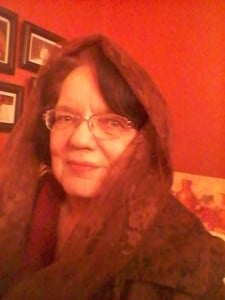 You hear stories all the time about supposed apparitions and supernatural events: Jesus in a soft taco; a crucifix in the clouds; an image in the glass on the side of a building; a statue of Mary that weeps. If you pride yourself on being a rational person, you may chuckle to yourself and shake your head, wondering why people are so gullible, so willing to embrace such superstitions.
You hear stories all the time about supposed apparitions and supernatural events: Jesus in a soft taco; a crucifix in the clouds; an image in the glass on the side of a building; a statue of Mary that weeps. If you pride yourself on being a rational person, you may chuckle to yourself and shake your head, wondering why people are so gullible, so willing to embrace such superstitions.
The story of Our Lady of the Underpass is one such extraordinary story. I wasn’t there when it happened; I’ve not seen it in the five years since then. I tend toward skepticism. But I’ve got to say that whether or not the image is truly the Mother of God, there has been a positive result in the lives of many Chicagoans.
Would it be better if people turned, not to a faded image on a concrete wall, but to the Real Presence of Jesus in the Eucharist in their local church? Well, yes.
 But if a particular apparition or image causes people to pause, to reflect on their faith commitments, to pray—then isn’t there at least some good that comes from it? Of course, we hope that their prayer and introspection will lead them to an increased awareness of God in their lives, to an authentic faith which is lived through the Sacraments and the Church. But our all-creative God can reach us through many means; and God can use a faded concrete image to touch hearts.
But if a particular apparition or image causes people to pause, to reflect on their faith commitments, to pray—then isn’t there at least some good that comes from it? Of course, we hope that their prayer and introspection will lead them to an increased awareness of God in their lives, to an authentic faith which is lived through the Sacraments and the Church. But our all-creative God can reach us through many means; and God can use a faded concrete image to touch hearts.
Here is the story.
* * * * *
Chicago’s Fullerton Avenue is a busy thoroughfare, one of a network of highly traveled commuter routes that escape the city by burrowing under the Kennedy Expressway. The concrete is sometimes cracked and greasy, marked by skid marks and the occasional pothole.
And by the Blessed Virgin Mary.
At least, that’s what Obdulia Delgado saw on April 10, 2005. Delgado was driving westward on Fullerton Avenue, going home from her job at St. Elizabeth Hospital, when she saw it: a life-sized stain in salt and soot and oil, the unmistakable outline of Our Lady of Guadalupe, on the crumbling concrete wall of the viaduct beneath the bridge.
The image appeared along a section of roadway called the Fullerton Avenue Accident Investigation Site—a stretch where the road widens to allow police and emergency vehicles to stop without impeding traffic. Delgado—stunned by what seemed to her to be a vivid message from the Mother of God—slipped into the emergency lane, got out of her car, and fell to her knees in prayer.
Later Delgado went home and told her husband Fidel, who was skeptical until he saw it for himself. At the site the following morning, Fidel Delgado described his shock when he first saw the detailed image. The couple determined that they would share the story with others—and by later Sunday afternoon, more than 100 people gathered on Fullerton Avenue to see for themselves and to pray.
In the days and weeks that followed, believers—many of them of Puerto Rican heritage—decorated the site with candles and flowers. The shrine was protected by sawhorses, and police were assigned to provide protection for the growing throngs of curiosity-seekers and faithful who gathered. Someone erected a cinder block frame around the Virgin’s muddy feet, marking the spot and protecting it from damage.
As national media converged on the Fullerton Avenue Accident Investigation Site, trouble ensued. After three weeks, a bicyclist stopped and scrawled “Big Lie” across part of the image in shoe polish. Concerned that the site had become a target and a traffic hazard, maintenance workers sprayed the entire image, covering it with brown paint. Shortly after, though, employees of a local carwash used a degreasing agent to scrub away the paint and the shoe polish—restoring the image to nearly original condition.
Even in its diminished form, the image drew visitors by the hundreds.
One bishop of the Evangelical Catholic Church, a denomination which is not affiliated with the Roman Catholic Church, insisted that the image and the ensuing hoopla demonstrate a spiritual hunger in the lives of many. “This has not faded away,” said Bishop James A. Wilkowski, leader of the Protestant denomination of 5,000. “Places like this are a testament to people’s faith. You can’t take away faith, no matter how hard you try. You can dismiss it, you can belittle it, but faith is far more powerful than a paint-over job.”
Wilkowski added that while this may not be like Lourdes or Fatima, two apparitions which have been investigated and have been determined by the Roman Catholic Church to be worthy of belief, something happened in Chicago that touched people and caused a response.
 In 2011 Tanya Saracho, a talented young Chicago writer, scripted a play titled “Our Lady of the Underpass” which was performed at Chicago’s Greenhouse Theater. Rather than taking sides, declaring that the image is truly from heaven or is a silly superstition focused on a salt stain, Saracho focuses in her play on the people who visit the site: Puerto Rican, Mexican, Polish, immigrant and yuppie, white and black.
In 2011 Tanya Saracho, a talented young Chicago writer, scripted a play titled “Our Lady of the Underpass” which was performed at Chicago’s Greenhouse Theater. Rather than taking sides, declaring that the image is truly from heaven or is a silly superstition focused on a salt stain, Saracho focuses in her play on the people who visit the site: Puerto Rican, Mexican, Polish, immigrant and yuppie, white and black.
But the wisest words came, I think, from the leader of the Roman Catholic Archdiocese of Chicago, Cardinal Francis George. Asked about the image at a press conference, the Cardinal called it a natural occurrence, but one which has been helpful in stirring faith. “God has many ways to stir up devotion in people’s hearts,” Cardinal George began. “It’s a purely natural phenomenon. If it’s helpful in reminding people of the Virgin Mary’s care for us and love for us, that’s wonderful.”










